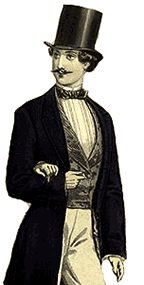 Dressing was a very important part of Victorian lifestyle. Both, men and women paid lot of attention to dressing properly according to the time and event. Gentlemen’s fashion was mostly influenced by the upper section of the society. What the Queen’s husband and royal consort wore in public became the latest fashion often.
Dressing was a very important part of Victorian lifestyle. Both, men and women paid lot of attention to dressing properly according to the time and event. Gentlemen’s fashion was mostly influenced by the upper section of the society. What the Queen’s husband and royal consort wore in public became the latest fashion often.
 Victorian Men’s Shirt
Victorian Men’s Shirt
Normally the colour of the shirt used to be white and the material was always starched, elaborate cravat style of the preceding regency era fell off gradually and shirt collars began to change. Men started opting for shorter collars often while folded down wing tip style was also seen and preferred by some. For formal occasions men used to wear detachable collars and cuffs. However, style of the work shirt was less rigid and usually included pull-over styles, full-placket and bib fronts. The wardrobe was full with wide variety of colours, stripes and patterns.
Collars and Cuffs
The shirt changed very little with time, just the frills on evening wear disappeared completely by 1860s. The front was stiffly starched and secured with attractive studs. Collars were detachable and the cuffs were also highly starched. Cuffs were at least one inch beyond the coat’s sleeves and for formal occasions they were doubled and fastened with cufflinks. Between 1850 to 1880, collars were lower, single and straight normally while winged for formal occasions. They were turned over for informal times.
By the 1890s collars 21 – 3 inches high were once again in fashion. Many old men continued to wear collars high and pointed projecting to the cheeks. However, this was more the fashion of the youth at that time.
Colours And Patterns in Shirt
Coloured shirts were introduced among working class in 1850s and continued to be popular in 1860s. However, by 1890s stripes of light blue or pink was introduced, but gentlemen mostly wore white shirt. In 1860s French Cambridge with colourful patters made its way to fashion and was used for informal wear. Artistic, intellectual and unconventional gentlemen wore solid coloured shirts.
 Victorian Cravat or Necktie
Victorian Cravat or Necktie
Cravat appeared in fashion in 1660s. Stylish men used to accessorize their necks with cravat. Early cravats were made of long white fabric decorated with embroidery or lace in the ends. There were several methods of tying them from a single knot with the ends hanging to a dashing bow. Cravat was replaced by stock, a stiff folded cloth that covered the neck and was buttoned or buckled at the back of the neck. This came into fashion in early 18th century.
However, cravat entered the nineteenth century also and was fashionable to wear in two layers – one was wrapped around the neck like stock and the other, a coloured cravat was tied in a decorative manner on the top. By the mid of the century, cravats were tied in small bows and are considered as the first bowties. By this time, the cravats were of black or coloured fabric and the white one was used only for formal occasions.

During the 1850s a broad necktie that was tied in a bow was worn. This along with the small neat bow continued to be in the fashion and were favoured during 1890s. Black bow started to be seen by the end of the century.